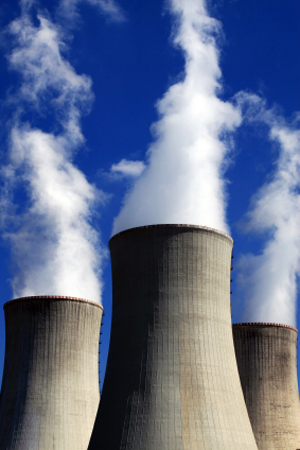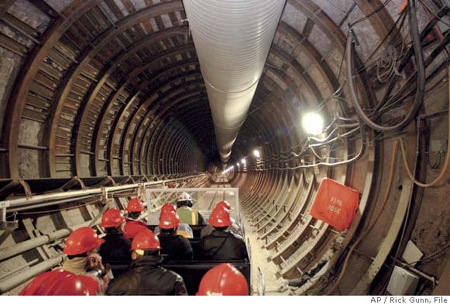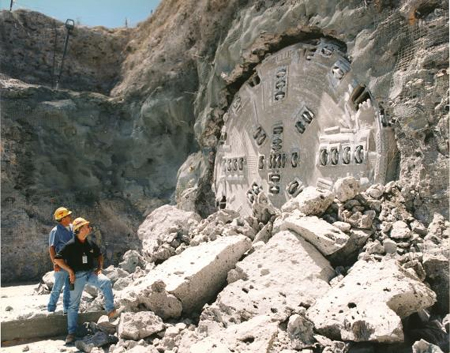The U.S. saw a boom in nuclear energy plants in the 195’s, when nuclear energy was widely regarded as the wave of the future. In 1979, however, the core reactor meltdown at the Three Mile Island nuclear facility near Harrisburg, Pennsylvania, changed the nation’s optimistic views on nuclear power.
Lately, however, there’s been a resurgence of interest in nuclear energy as a renewable energy source, and the Obama administration has even gone so far as to approve two new nuclear reactors for the state of Georgia. If built, these plants will be the first nuclear plants started in the US since the 1970’s, according to the New York Times.
Is nuclear energy a viable alternative to to fossil fuels, foreign oil and global warming? Or is it a form of energy that creates as many environmental problems as it aims to solve? In order to get a handle on both sides of the debate, we spoke with Steven Kerekes, spokesperson for the Nuclear Energy Institute, and Jim Riccio, nuclear energy campaign manager for Greenpeace. You can already guess who has opinions on what side of the issue.

The Argument for Nuclear Energy
Kerekes highlights nuclear energy as a technology with the power to reliably and affordably provide large amounts of electricity on virtually a non-stop basis. He points out that nuclear power has been proven over the course of 3,500 combined reactor-years of operation in the United States and 14,000 combined reactor-years of operation worldwide.
According to Kerekes, the U.S. Department of Energy (DOE) estimates U.S. demand for electricity will increase 23 percent by 2030 – the equivalent of 200-plus full-scale power plants – and all independent analyses of climate change (including studies conducted by the National Academies of Science, the U.S. Environmental Protection Agency and DOE) conclude that meeting demand while at the same time reducing carbon emissions requires a clean energy technology portfolio in which nuclear energy plays a prominent role.
As far as safety goes, Kerekes believes we’ve come a long way since Three Mile Island. “First, this isn’t 1979 or 1989 or even 1999,” he told us. “Reforms put in place after the Three Mile Island accident have led to vast improvement in the training of nuclear plant personnel, in the sharing of operational information throughout our industry, and in the efficiency, reliability and cost-effectiveness of our facilities.” He highlights changes in the federal Nuclear Regulatory Commission and the success of the Institute of Nuclear Power Operations, which were created to create greater oversight on nuclear plants following Three Mile Island.
Which leaves the final conundrum–what to do with the high-level nuclear waste created by nuclear reactors. “Used nuclear fuel has been safely and securely stored on plant sites for a half-century in used fuel pools or in dry storage (concrete and steel containers),” Kerekes told us, “and the Nuclear Regulatory Commission has determined that used fuel can be safely stored on plant sites for another century.”
He goes on to note that, as far as long-term disposal goes, U.S. Secretary of Energy Steven Chu this year established a Blue Ribbon Commission to develop policy recommendations by the end of 2011 for the long-term disposition of used fuel–but that under any used fuel management scenario, it will be necessary to move radioactive byproducts to a permanent underground repository (what’s known as deep geologic storage).

The Case Against Nuclear Energy
Jim Riccio, Nuclear Energy Campaign Director for Greenpeace, disagrees with Kerekes on several key points. One of them is the affordability of nuclear energy. He points out that the U.S. Department of Energy’s most recent national energy analysis has the capital costs associated with building a nuclear plant up between 25% to 37% over last year–numbers corroborated by Platts, a leading source of energy information. Riccio believes that when the price of building a nuclear energy plant is factored into the cost per watt equation, nuclear energy cannot compete in the marketplace.
Then there’s the problem of waste. The flaw inherent to the deep geologic disposal scenario, according to Riccio, is that “nothing you put the waste in will last longer than the waste itself, so burying it basically acquiesces to the fact that it will eventually leak….just like every other radioactive dump site.” He highlights problems with Nevada’s Yucca Mountain nuclear storage facility as the case in point.
The site was selected by the federal government in order to comply with Nuclear Waste Policy Act of 1982, which called for the development of a national site for spent nuclear fuel and high-level radioactive waste storage. The facility was supposed to start receiving high-level nuclear waste in 1998, but $13 billion (Editor’s Note: This was reported as $13 million, but is actually $13 billion) and 12 years later, it has all but been abandoned, as the project had proven widely unpopular in Nevada and, according to a New York Times article, the site opens up the possibility of groundwater contamination. High-level nuclear waste must be stored for hundreds of thousands of years before it becomes safe to release into the biosphere, which raises serious questions concerning whether any truly safe place for deep geologic storage exists.

As far as safety and security, Riccio says, “Those who say safety isn’t an issue have not been paying attention. We came really close to another meltdown here in the US in 2002 in Ohio at Davis Besse.” He goes on to note that as the Nuclear Regulatory Commission runs reactors beyond their originally licensed lives, more of these near misses will occur–and that, unlike solar projects or wind farms, nuclear reactors can also pose threats to national security in the age of terrorism.
So what do you, the reader, think of nuclear power as a form of clean energy? Yes or no and why? Leave your thoughts below in the reply box.